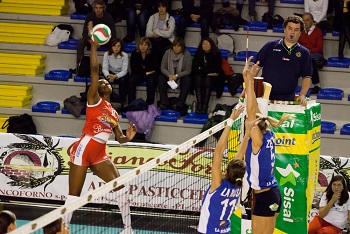The following volleyball spike tips are the basic steps to learning how to hit a volleyball. Learning how to spike involves creating topspin and contacting the ball in away that allows you to be in control of the attack.
Volleyball Spike – Mastering the Contact Position
The most important part of spiking is the contact. How you contact the ball will determine how well you volleyball spike.
The following are the 3 most important concepts for spiking…
- Contacting the ball with a vertical arm.
- Contacting the ball using an elbow to wrist arm action.
- Contacting the ball in a way that creates topspin.

Get the Elbow up and Contact with a Vertical Arm
A “vertical arm” means the arm is perpendicular to the ground. We want the arm to be vertical because a vertical arm allows you to make a higher contact and more powerful spike. A lot of players will reach a few inches higher just by making this adjustment.
Watch yourself on video
If you are unsure if your arm is vertical or you have a coach constantly telling you to get your elbow up and you can’t feel it, then film yourself spiking. If you see it on film it’s easier to understand what it means to have a vertical arm.
Get your elbow close to your ear
Often a good cue is to start with the elbow close to your ear before you spike. This will put your arm in a vertical position before you swing to contact the ball.
Contact the ball With an Elbow to Wrist Arm Action
The elbow to wrist arm action is the last part of the spike. It’s usually best to work on this armswing first before learning to approach because trying to approach and get your arm vertical and use elbow to wrist is often too many things to think about when first learning how to volleyball spike.
If you enjoyed these tips and would like to keep it close to you at any time, just save this pin to your Pinterest Volleyball Training Board.

“Hammer Position” for Spiking
Start with just an elbow to wrist action. Don’t follow through. Use a wall or find a partner and work on elbow to wrist.
Think of just moving the arm from elbow to wrist. For example, from shoulder to elbow there shouldn’t be much arm motion. Most of the movement is from elbow to wrist.
It’s like hammering in a nail. Imagine you are hammering in a nail up overhead. In the photo on the right, the arm is in the hammer position, ready to spike.
Contact the Ball Creating Topspin
Often a tough concept to grasp is spiking with topspin.
The purpose of topspin is…
- Contacting the ball in a way that gives you more ball control. Spin = Control. Every time you volleyball spike, you should be contacting the ball in a way that creates spin. The exception is when serving. Serving the ball with “no spin” is called a float serve. The purpose of a float serve is to serve the ball in a way that the ball floats making it hard for the opponent to pass.
- Topspin makes the ball drop into the court. Often the ball will sail out of bounds because the ball doesn’t have topspin.
- Topspin can be deceptive. A server with really good topspin can serve the ball deep and drop it in the court. This is often very deceiving and results in aces.
- Topspin creates confidence. Players that learn how to hit with spin are more confident because they have more spiking control. If a player can consistently hit with spin, they will be easier to adjust to sets which results in spiking with more confidence.
Home › Techniques › Spiking Tips
